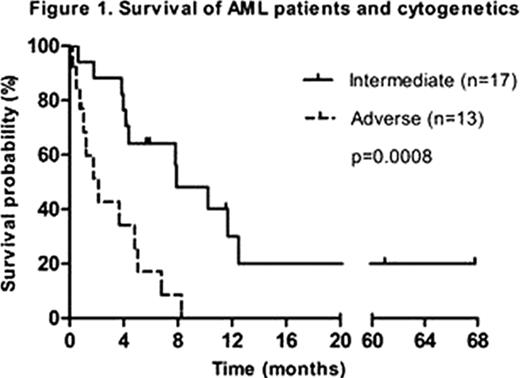Abstract
Abstract 4305
Treatment options are limited for refractory acute leukemia (AL) patients. Few data are available on the potential utility vs futility of a third course of induction chemotherapy. We have reviewed the characteristics and outcome of 35 patients treated with a third intensive induction course for refractory AL at our institution and other centers affiliated to the Quebec Leukemia Cell Bank (BCLQ).
Adult AL patients who never achieved complete remission (CR) or who relapsed within 6 months after 2 consecutive induction courses and who received a third line intensive induction course between 2000 and 2010 were included in this study. Clinical, laboratory and treatment data were collected from hospital and/or BCLQ files. Outcomes were measured after the third induction course. Primary outcomes were achievement of CR/CRi, overall survival (OS) at 12 months and event-free survival (EFS), defined as the percentage of patients alive and leukemia free at 12 months. Secondary outcomes included median OS, median duration of remission for those obtaining CR and treatment related mortality (TRM) associated with the third induction course. OS was estimated using the Kaplan-Meier method and survival curves were compared using the Log-rank test. Alive patients were censored at their last follow-up.
Thirty five patients met the inclusion criteria. The median age was 43 years old (20–62). Thirty one patients (89%) were diagnosed with AML and 4 patients (11%) with ALL or acute leukemia of ambiguous lineage. The median white blood cell count at diagnosis was 23 × 109/L (0.7–223). For AML patients, cytogenetics was favourable in 1 patient (3%), intermediate in 17 (55%) and adverse in 13 (42%). None of the 6 patients with normal karyotype for whom molecular characterisation was performed had a favourable genotype defined as NPM1 mutated without FLT3-ITD mutation. The patient with favourable karyotype had a variant t(8;21)(q22;q22) translocation without KIT mutation. Eighteen patients (51%) were primarily refractory to prior therapy and 17 (49%) had relapsed within 6 months of CR. The third line induction regimen consisted of cyclophosphamide and etoposide in 11 patients (31%), high dose cytarabine-based regimen in 10 (29%), mitoxantrone and etoposide in 7 (20%), fludarabine, cytarabine and idarubicin in 5 (14%) and other regimen in 2(6%). Patients with sustained remission after their third induction course were followed for a minimum of 12 months except for one patient alive and leukemia free at 6 months. Patients who were not in sustained remission have all been followed until death or transition to palliative care.
CR after the third induction course was achieved in 6 patients (17%). At 12 months, OS was 11% and EFS was 6%. After the third induction, median OS was 5 months and median duration of remission was 6 months. Among 20 patients treated in our institution, the third induction TRM was 15% and median duration of hospitalisation, excluding patients who died in aplasia, was 38 days (20–70). Median OS was higher in the intermediate than in the adverse cytogenetics group (8 vs 2 mo, p=0.0008, figure 1) and in patients who achieved CR after third induction vs no CR (12 vs 4 mo, p=0.03). There was no difference in median OS between primary refractory and relapsed patients (8 vs 4 months, p=0.52).
Allogeneic stem cell transplantation (SCT) was performed in 10 patients (29%) of whom 4 (40%) were in CR before transplantation. The only two long term survivors were in the allogeneic SCT group. Their percentages of blasts at transplant were 3 and 69 %.
Only two refractory patients are long term survivors and they share several features: non adverse cytogenetics, young age (20 and 23) and they underwent allogeneic SCT. Adverse cytogenetics impinges negatively on outcome, even in this highly refractory group of subjects.
The prognosis of AL patients with persistent disease after 2 induction courses is extremely poor and represents a major unmet therapeutic need. Refractory patients with adverse cytogenetics were unsalvageable in this series. The best approach for patients not in CR after 2 inductions probably remains allogeneic SCT, when possible. We consider that in patients who cannot be offered an allogeneic SCT, administration of a third course of conventional chemotherapy is practically useless. These patients should be considered candidates for investigational treatments.
Bergeron: Merck: Research Funding; Roche: Honoraria; Celgene: Research Funding.
Author notes
Asterisk with author names denotes non-ASH members.


This feature is available to Subscribers Only
Sign In or Create an Account Close Modal